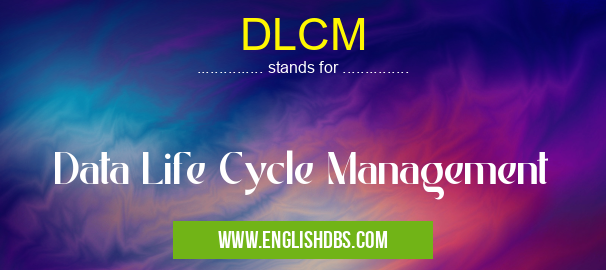What does DLCM mean in MANAGEMENT
Data Life Cycle Management (DLCM) is a comprehensive strategy and approach to managing data from its creation to its eventual disposal or archival. DLCM focuses on ensuring that the right data is available at the right time for the correct purpose, while also safeguarding it against unauthorized access and protecting it from loss or corruption. By implementing a reliable DLCM system, organizations can ensure that their data remains secure and relevant throughout its life cycle.

DLCM meaning in Management in Business
DLCM mostly used in an acronym Management in Category Business that means Data Life Cycle Management
Shorthand: DLCM,
Full Form: Data Life Cycle Management
For more information of "Data Life Cycle Management", see the section below.
» Business » Management
Benefits of DLCM
The implementation of an effective DLCM process provides numerous benefits to organizations. First, it helps them keep track of sensitive information in regards to security and privacy regulations. Furthermore, it allows businesses to better understand their assets by having control over the complete life cycle of their collected data sets. Finally, organizations can ensure that only the necessary data is retained in order to comply with industry guidelines as well as legal requirements. As such, an efficient DLCM system enables companies to gain a better understanding of their operations while reducing exposure risks associated with mishandling data.
Essential Questions and Answers on Data Life Cycle Management in "BUSINESS»MANAGEMENT"
What is Data Life Cycle Management?
Data Life Cycle Management (DLCM) is the systematic process of planning and controlling the entire life cycle of data, from the initial collection and storage to its eventual archiving or deletion. It helps to ensure that stored data remains useable, secure, and accessible throughout its lifecycle.
What are the benefits of DLCM?
DLCM can help organizations optimize their storage resources by properly managing the flow and use of data. It also ensures compliance with any applicable laws and regulations, as well as provides safeguards against potential security threats. By having a well-defined plan in place for managing data, organizations can limit their risks and maximize the value of their data assets.
What does a DLCM system do?
A DLCM system can be used to track data assets throughout their entire lifecycle, from acquisition through storage to archiving or deletion. It helps organizations ensure that all stored data is adequately protected and remains compliant with any local rules or regulations governing its use. DLCM systems typically provide users with access control features, reporting capabilities, audit logs, graphical interfaces for tracking usage patterns, and automated processes for performing routine maintenance tasks.
How does DLCM help ensure regulatory compliance?
As part of its larger role in managing stored data assets, a DLCM system can help organizations meet applicable legal requirements such as those related to privacy or record retention policies. By tracking which user has accessed each asset over time and monitoring all changes made to it, organizations can easily demonstrate compliance when needed.
How does DLCM help prevent security risks?
A robust DLCM system can provide several layers of protection when it comes to ensuring security for stored data assets. Access control features allow users to assign different levels of access permissions based on roles or groups while audit logs keep track of every action taken across the system so administrators can promptly detect any unusual activity or suspicious behaviour. Additionally, regular backup copies are kept so that if needed deleted files can be easily recovered without significant disruption to ongoing operations.
Is there a standard way that most people approach DLCM? A: While there may be some variations depending on an organization's individual needs and circumstances, many businesses tend to follow similar approaches when it comes to managing their data life cycles. This includes having clearly defined phases such as collection/acquisition; storage/archival; usage/disclosure; analysis; review/audit; policy development; maintenance/update; destruction/deletion; monitoring; service level agreements (SLAs); assessment & optimization.(END) Q: Who is responsible for overseeing DLCM activities within an organization?
While there may be some variations depending on an organization's individual needs and circumstances, many businesses tend to follow similar approaches when it comes to managing their data life cycles. This includes having clearly defined phases such as collection/acquisition; storage/archival; usage/disclosure; analysis; review/audit; policy development; maintenance/update; destruction/deletion; monitoring; service level agreements (SLAs); assessment & optimization.(END)
Q: Who is responsible for overseeing DLCM activities within an organization?
A: The primary responsibility for ensuring proper adherence to a company’s Data Life Cycle Management policy rests with IT personnel within an organization who are familiar with best practices around handling sensitive information effectively and securely. In addition, management should collaborate closely with other departments in order identify gaps in existing procedures and create a comprehensive strategy for embodying these guidelines across all operations within an enterprise.
Final Words:
In conclusion, Data Life Cycle Management (DLCM) is an essential process for businesses looking to improve their information management system while maintaining compliance with applicable laws and regulations. As such, proper management of an organization’s collected data sets throughout their respective life cycles will enable them to effectively analyze risk levels associated with various operations while also protecting against unauthorized access or misuse of sensitive information assets.
